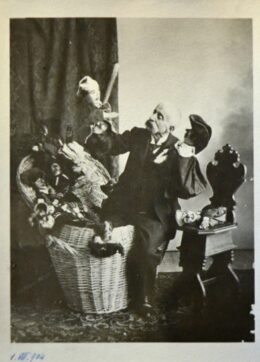Handwritten summary
14 pages
Author(s)
Ercole all'Inferno
con Faggiolino spaventato dai mostri infernali
As was the case for many of Angelo Cuccoli’s manuscripts, Ercole all'inferno con Faggiolino spaventato dai mostri infernali (Hercules in the Underworld and Faggiolino horrified by hellish monsters) is a simple summary of the story. The play, which uses the myth of Alcestis, is part of a series of “comedies” with mythology as its subject, written by Angelo Cuccoli (Edipo re di Tebe, La morte di Edipo…)
The second page of the text indicates that the play was performed to celebrate the Cuccoli family’s 60th year of activity in the field of puppetry. The manuscript ends with a nursery rhyme written in the Bolognese dialect and in which Angelo Cuccoli recounts the years of involvement of his father Filippo, who entertained the people of Bologna starting from 1831 with a puppet of Sandrone, and he thanks the audience for still following the shows which feature Faggiolino.
The same theme has been explored by other Italian puppeteers such as Aldo Rizzoli, who reused it in his own Ercole all’Inferno which features the same characters.
The hero brings a woman back from the underworld
Admeto (Admetus), ill and dying, goes to see the oracle of Giove (Jupiter) in order to learn how to stay alive: he can only survive if someone dies in his stead. His wife Alceste (Alcestis) is the only one who accepts to die for him. Ercole (Heracles) asks for the hospitality of the court of Admeto, and there he narrates his labours. He promises his host that he will bring Alceste back from the underworld. Accompanied by the servant Faggiolino, Ercole descends to the underworld, where he kills several antagonists, and asks Plutone (Pluto) to bring Alceste back to life. Because Plutone refuses, Ercole kidnaps Alceste. Back on Earth, Ercole, Faggiolino and Alceste are welcomed with a sumptuous feast, and Faggiolino is promoted Great of the court.
First performance
Piazza de Marchi (nowadays Piazza S. Francesco)
